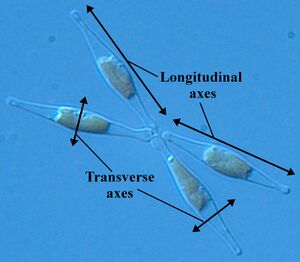Diatom

Description
Diatoms are tiny, single-celled algal plants that are made of silica and other minerals. They are typically found in marine environments, but can survive in other areas with enough moisture, including soil habitats. Each of the more than 8000 species has a skeleton that is ornate and symmetrical, unique from that of every other species. The skeletons can take the shape of crescents, discs, rectangles, triangles, stars, or other different geometric shapes. One of its byproducts, called diatomaceous earth, has various practical applications due to its silica content and extremely small size [2].
Taxonomy
[3].
| Domain: | Eukaryota |
|---|---|
| Kingdom: | Plantae |
| Clade: | Diaphoretickes |
| Phylum: | Gyrista |
| Subphylum: | Ochrophytina |
| Superclass: | Khakista |
| Class: | Bacillariophyceae |
| [4] | |
Ecology
The lack of data on the ecology of terrestrial diatoms is the greatest barrier to future research. Terrestrial diatoms can be used as indicators for the quality of both aquatic and soil environments. Also, land use and soil pH are important factors in determining the ecological condition of the diatom sites and have the greatest influence on how their communities are structured. Studies looking at soil algae populations as a whole have revealed that they are very sensitive to disturbance causes [5]. In a range of terrestrial environments, including soils, mosses, wet walls, and rocks, many taxa may persist and reproduce. For diatoms, forests provide a stable microhabitat, and agricultural techniques, rather than seasonal variations in environmental factors, regulate the majority of the diatom communities' temporal fluctuation [6].

Anatomy
The skeletons that make up their structure, called frustules, can be [8]. [9].

References
[1] "Mixed diatom frustules" by Carolina Biological Supply Company is licensed under CC BY-NC-ND 2.0
[2] Calvert, R. (December 1930). "Diatomaceous earth". Journal of Chemical Education, 7(12), 2829. doi:10.1021/ed007p2829
[3] Blanco, S. (May 2020). "Diatom taxonomy and Identification Keys. Modern Trends in Diatom Identification". Developments in Applied Phycology, vol 10. Springer, Cham. 25–38. https://doi.org/10.1007/978-3-030-39212-3_3
[4] Retrieved May 6, 2023, from the Integrated Taxonomic Information System (ITIS) on-line database, www.itis.gov, CC0 https://doi.org/10.5066/F7KH0KBK
[5] Antonelli, M., C. E. Wetzel, L. Ector, A. J. Teuling, and L. Pfister. (April 2017). "On the potential for terrestrial diatom communities and diatom indices to identify anthropic disturbance in soils" Ecological Indicators 75:73–81. https://doi.org/10.1016/j.ecolind.2016.12.003
[6] Foets, J., C. E. Wetzel, A. J. Teuling, & L. Pfister. (January 2020). "Temporal and spatial variability of terrestrial diatoms at the catchment scale: Controls on communities". PeerJ 8. https://doi.org/10.7717/peerj.8296
[7] "Ocean carbon cycle and diatom carbon dioxide concentration mechanisms 2" by Juan José Pierella Karlusich, Chris Bowler, and Haimanti Biswas is licensed under CC BY-SA 4.0
[8]
[9]
[10] "Longitudinal Diatom (Labelled)" by Esseh~commonswiki is licensed under CC BY-SA 3.0